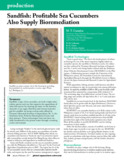Development of integrated multi-trophic aquaculture using sea cucumber
- Global styles
- MLA
- Vancouver
- Elsevier - Harvard
- APA
- Help

Download URL
spo.nmfs.noaa.govDate
2017Page views
2,486ASFA keyword
AGROVOC keyword
Taxonomic term
Metadata
Show full item record
Share
Abstract
In Southeast Asian countries, aquaculture production continues to increase. Environmental deterioration associated with water and sediment eutrophication by aquaculture effluent has been problematic, sometimes resulting in disease outbreaks and fish kills due to hypoxia and hydrogen sulfide poisoning. Integrated multi-trophic aquaculture (IMTA) is one of the promising measures for sustainable aquaculture. In this study, a box model estimation of nitrogen (N) budget based on experimental data and values from literature was made for a system of sandfish (Holothuria scabra) in sea cage IMTA with milkfish (Chanos chanos) and Elkhorn sea moss (Kappaphycus alvarezii).
Information on stocking density, stocking size, mortality, growth, feed ration, feed assimilation, NH4-N production and NH4-N absorption of these species was obtained from a series of experiments and existing literature. In the production system 26 g milkfish were cultured in a 5 x 5 x 4 m cage at the stocking density of 36.7 ind/m3 with the initial feeding ration of 10% of body weight which was gradually decreased to 4% over time; 10 g sandfish were cultured in a cage with the same bottom area as milkfish cage hanged under the milkfish cage to trap particulate N waste (i.e. feces and leftover feed) at the stocking density of 35 ind/m2; the stocking weight of Elkhorn sea moss line culture was 10 kg; culturing period was 200 days.
It was estimated that milkfish culture cumulatively produced 145 kg of particulate N, and milkfish and sandfish together produced 60 kg of NH4-N in 200 days of culture. Daily assimilation rate of the particulate N by sandfish ranged 3.4 - 12.4%, and 4.3% of the particulate N was estimated to be removed by sandfish in 200 days of culture. Daily absorption rate of NH4-N by Elkhorn sea moss increased exponentially with time and reached 100% after 125 days of culture. Cumulative NH4-N was estimated to be depleted after 162 days of culture. For complete utilization of particulate N by the end of culture, sandfish stocking density should be 805 ind/m2, which is 200 times as high as that in existing sandfish aquaculture operations.
Suggested Citation
Watanabe, S., Kodama, M., Sumbing, J. G., & Lebata-Ramos, M. J. H. (2017). Development of integrated multi-trophic aquaculture using sea cucumber. In K. Gruenthal, P. Olin, M. Rust, & E. Trentacoste (Eds.), Genetics in Aquaculture: Proceedings of the 42nd U.S.-Japan Aquaculture Panel Symposium, La Jolla, CA, October 1, 2014 (pp. 80-87). Silver Spring, MD: United States Department of Commerce, National Oceanic and Atmospheric Administration, National Marine Fisheries Service.
Type
Conference paperSeries
NOAA technical memorandum; NMFS-F/SPO-168Collections
- Conference Proceedings [299]
Related items
Showing items related by title, author, creator and subject.
-
Ration reduction, integrated multitrophic aquaculture (milkfish-seaweed-sea cucumber) and value-added products to improve incomes and reduce the ecological footprint of milkfish culture in the Philippines
de Jesus-Ayson, Evelyn Grace T.; Borski, Russel J. (AquaFish Collaborative Research Support Program, Oregon State University, 2012)In the Philippines, cage culture of milkfish in marine environments is increasing. The practice uses high stocking densities, with significantly greater inputs of artificial feeds which more often than not, have led to ... -
Series: ACIAR Proceedings; No. 136
Overview of sea cucumber aquaculture and sea-ranching research in the South-East Asian region
Mills, David J.; Duy, Nguyen Dinh Quang; Juinio-Meñez, Marie Antonette; Raison, Christina M.; Zarate, Jacques M. (Australian Centre for International Agricultural Research, 2012)South-East Asia has traditionally been the global centre of production of tropical sea cucumbers for Chinese markets. Early research into culture methods took place outside this region, notably in India, the Pacific region ... -
Sandfish: Profitable sea cucumbers also supply bioremediation
Castaños, Milagros T.; Ledesma, Rossea V.; Corre, Kaylin G.; de Jesus-Ayson, Evelyn Grace (Global Aquaculture Alliance, 2011)Sandfish, a type of sea cucumber, are both a high-value culture species and one that supports the aquaculture of other fish species by cleaning up waste on the bottoms of ponds or sea cages. Hatchery and nursery technologies ...






